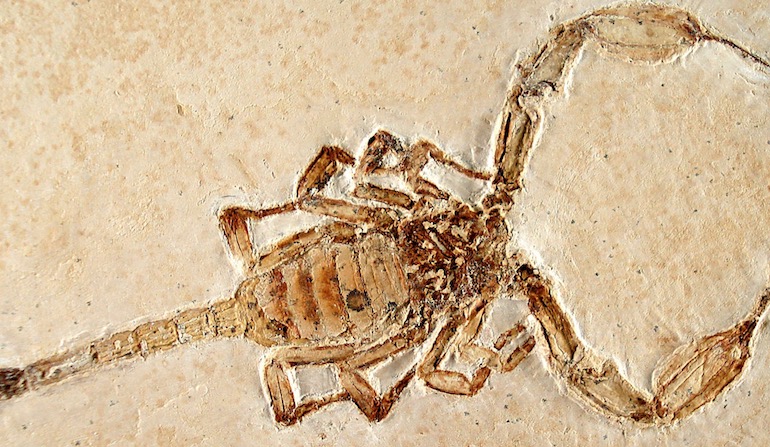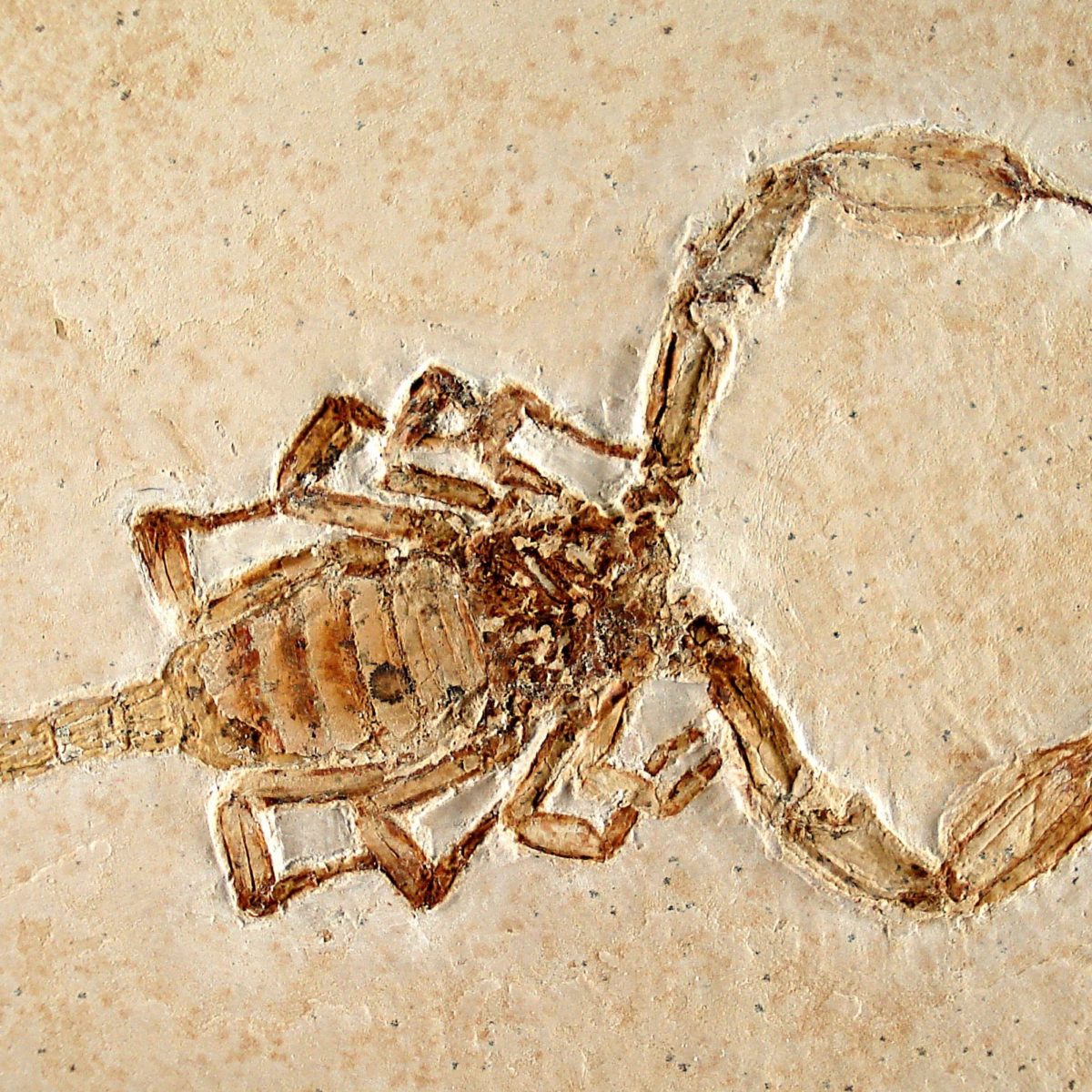 Evolution
Evolution
The Oldest Scorpion and the Decadence of Evolutionary Science


A few days ago a new paleontological discovery hit the news headlines around the globe. The oldest fossil scorpion ever found had been described and it was said to provide clues to the evolution of life on land. Of course, I was eager to read the original paper; not at all with a malevolent intention, looking to find a fly in the ointment, but honestly interested and fascinated by this subject. Boy, was I in for a big surprise, the unpleasant sort. I am not easily shocked, but this paper shocked me. So what was wrong with it? Well, usually peer reviewers receive a check list from the editors that includes the question, “Do the data support the conclusions?” This paper fails miserably and it is beyond me how it could ever pass peer review. But let’s not get ahead of ourselves.
Let Us First Look at the Discovery
Andrew Wendruff from Otterbein University in Ohio and his collaborators (Wendruff et al. 2020) published in the Nature journal Scientific Reports. Their paper is titled, “A Silurian ancestral scorpion with fossilised internal anatomy illustrating a pathway to arachnid terrestrialisation.” They describe two conspecific fossil specimens from the 437-million-year-old Waukesha Lagerstätte in Wisconsin. These two Lower Silurian fossils are the earliest scorpions ever found and exhibit a mixture of primitive and derived characters, including preserved internal organs of the circulatory, respiratory, and digestive system. This new evidence is claimed to illuminate the transition from marine to terrestrial life in arachnids. In their press release (Ohio State University 2020) they emphasize that “The discovery provides new information about how animals transitioned from living in the sea to living entirely on land.” Wow, that sounds really cool.
The general media reception greeting this apparent “breakthrough” discovery has been enthusiastic: CNN reports that “Prehistoric scorpion is earliest known animal to venture from sea onto land” (Hunt 2020). The Wall Street Journal celebrates this work with the headline “Ancient Scorpion Offers Clues to How Animals Moved from Sea to Land” (Camero 2020). Smithsonian Magazine agrees that the “World’s Oldest Scorpions May Have Moved From Sea to Land 437 Million Years Ago” (Wu 2020). Only in Ortega’s (2020) piece in Science do we find a cautiously critical comment, from renowned arachnologist Paul Selden. Concerning whether the fossils had lived in water or on land, he remarked that “Unfortunately, there’s really no evidence at all to swing it one way or the other.” Yes, that is a first hint as to where the paper goes wrong.
A Great Find, But…
First let me say what is good in this paper. The two fossil specimens it describes really are the oldest known fossil scorpions, and their Lower Silurian age is remarkable. Also, this new genus and species, Parioscorpio venator, differs from all modern arachnids in still having a pair of large lateral compound eyes and a higher number of sternites (ventral plates of the exoskeleton). This is clearly more primitive than any modern scorpion. It is therefore not correct when Uncommon Descent (2020) commented that “World’s Oldest Scorpions Show No Change From 437 Million Years Ago.” What hardly changed are the preserved features of the circulatory and respiratory system. The described preservation of these internal organs is highly exceptional and especially remarkable considering the ancient origin of these fossils. Great find! So far, so good.
But what about the really “sexy” part of the paper — the illumination supposedly cast how animals moved from ocean to land? Without this grandiose evolutionary implication the paper would never have made it into a prime journal like Scientific Reports but only into a specialized paleontology journal with a much lower impact factor. That would mean less of a chance for grant renewals.
Now to the Actual Misdeed
In the introduction the authors mention several characters that are commonly used to infer the aquatic or terrestrial habitat of fossil arachnids: “the presence or absence of feeding structures used to liquify prey (coxapophyses or stomathecae), chemosensory organs (pectines), mechanosensory organs (trichobothria), and respiratory structures (book gills or book lungs).” Surprise: The two described fossils have neither visible coxapophyses or stomathecae, nor visible pectines, nor visible trichobothria, and neither visible book gills nor book lungs. There is nothing in these fossils that could say anything about their way of life, and thus nothing that suggests how animals moved from sea to land. Actually, according to the authors the sediments are of marine origin and only yielded marine animals as fossils, but not a single terrestrial plant or terrestrial animal at all.
How on earth do the authors then arrive at their bold claim that the fossils “illustrat[e] a pathway to arachnid terrestrialisation”? They say in their discussion, “Anatomical details preserved in P. venator suggest that the physiological changes necessary to accommodate a marine-to-terrestrial transition in arachnids occurred early in their evolutionary history. Whether P. venator was a fully terrestrial arthropod is uncertain. The close similarity of its preserved pulmonary-cardiovascular structures with those of extant scorpions and horseshoe crabs hint at the possibility of extended stays on land.” What? They made very clear that the preserved pulmonary-cardiovascular structures are “essentially indistinguishable from those of present-day scorpions.” These identical structures show exactly nothing about how these structures or other adaptations for a life on land evolved. The similarities of these structures between extant terrestrial scorpions and marine horseshoe crabs only prove one thing, i.e. that these similarities are totally uninformative about the habitat of these animals. After all, horseshoe crabs are fully marine organisms that mate in the surf and only briefly crawl on the beach to lay their eggs either in shallow water or directly above the edge of the water and then immediately return into the ocean. The lineage of horseshoe crabs goes back 445 million years into the Ordovician era when Lunataspis aurora roamed the sea floors. We have no idea what the pulmonary-cardiovascular structures looked like in those earliest horseshoe crabs or even in their putative Cambrian ancestors. Nothing at all of what the authors describe provides any clue how organ systems changed in adaptation to a life on land. Nothing in the fossils is in any way intermediate between a marine and a terrestrial way of life. The only two primitive character states in these fossils (compound eyes and seven mesosomal sternites) have nothing to do with aquatic or terrestrial adaptation. Consequently, the main claim of the authors, which even made it into the title of this work, is totally unsupported by the data. Any decent reviewer should have recognized this at first glance, and then either requested a major revision or rejected the paper. But obviously this did not happen.
Venom, Not Poison
There also other minor shortcomings, such as the lack of a proper cladistic analysis and inconsistencies in the description. For example, in the discussion the authors list several characters of the new taxon, including “a narrow metasoma terminating in a stinger,” which they correctly consider as a derived similarity with modern scorpions. Unfortunately, the fossil has no stinger preserved. Actually, the authors themselves write further down in the same paragraph “but the more terminal stinger is not evident.” The authors also describe the alleged presence of a poison vesicle. This, incidentally, shows that they are not specialists, because in scorpions this structure is properly called the venom vesicle. In any event, since the terminal “segment” (telson), which could contain the venom vesicle, is likewise not preserved but possibly folded beneath the fifth tail segment, the curved outlines visible within this fifth metasomal segment could rather present the telson. It is quite possible that there was a venom vesicle and a stinger in the living animal, but it is not proper scientific procedure to describe unpreserved features instead of inferring them.
What do we learn from this case? In today’s science world it is no longer sufficient to objectively describe some nicely preserved ancient fossils. You must overinterpret the evidence and oversell their importance with a fancy evolutionary narrative. And you do not have to hesitate to be really bold with your claims, because neither the scientific reviewers nor the popular science media will care if your claims are actually supported by the evidence. This system is broken. It was broken by the pressure to publish or perish, by the pressure of public relation departments to generate lurid headlines, and by the pressure of the idiotic paradigm that nothing makes sense in biology except in the light of evolution. In entertainment and advertising, sex sells. In the news, it leads when it bleeds. In bioscience it rocks when it is an icon of evolution. Good science falls by the wayside.
Literature:
- Camero K 2020. Ancient Scorpion Offers Clues to How Animals Moved from Sea to Land. Wall Street Journal Jan. 16, 2020.
- Hunt K 2020. Prehistoric scorpion is earliest known animal to venture from sea onto land. CNN Jan. 16, 2020.
- Ohio State University 2020. Fossil is the oldest-known scorpion. Science Daily Jan. 16, 2020.
- Ortega RP 2020. This is the oldest scorpion known to science. Science Jan. 15, 2020.
- Wendruff AJ, Babcock LE, Wirkner CS, Kluessendorf J, Mikulic DG 2020. A Silurian ancestral scorpion with fossilised internal anatomy illustrating a pathway to arachnid terrestrialisation. Scientific Reports 10, 14. DOI: 10.1038/s41598-019-56010-z.
- Wu KJ 2020. World’s Oldest Scorpions May Have Moved from Sea to Land 437 Million Years Ago. Smithsonian Magazine Jan. 16, 2020.
- Uncommon Descent 2020. World’s Oldest Scorpions Show No Change From 437 Million Years Ago. Uncommon Descent Jan. 17, 2020.
Photo: Fossil scorpion from the Lower Cretaceous Crato Formation in Brazil, by G. Bechly.
